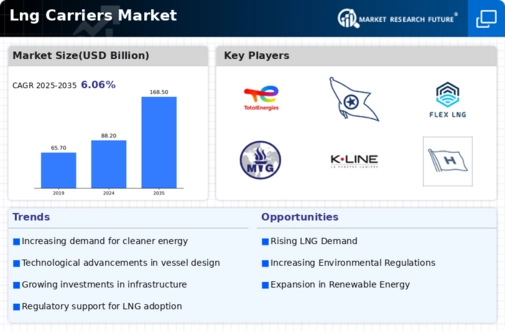Market Growth Projections
The Global Lng Carriers Market Industry is expected to experience robust growth, with a projected compound annual growth rate (CAGR) of 6.06% from 2025 to 2035. This growth is indicative of the increasing reliance on LNG as a primary energy source across various regions. Factors such as rising energy demands, coupled with the need for cleaner energy alternatives, are driving this upward trend. As countries continue to invest in LNG infrastructure and technology, the market is likely to expand significantly. This growth trajectory underscores the potential of the Global Lng Carriers Market Industry to adapt to changing energy dynamics.
Infrastructure Development
Significant investments in LNG infrastructure are propelling the Global Lng Carriers Market Industry forward. Governments and private entities are actively constructing new terminals and enhancing existing facilities to accommodate the rising demand for LNG. For example, the expansion of LNG terminals in the United States has facilitated increased exports, thereby boosting the market. This infrastructure development is crucial as it supports the efficient transportation and storage of LNG, ultimately contributing to the market's growth. The Global Lng Carriers Market Industry is likely to benefit from these advancements, ensuring a steady supply chain for LNG distribution.
Rising Demand for Natural Gas
The Global Lng Carriers Market Industry experiences a notable surge in demand for natural gas as countries transition towards cleaner energy sources. This shift is driven by the need to reduce carbon emissions and combat climate change. For instance, nations like Japan and South Korea are increasingly relying on LNG imports to meet their energy needs. As a result, the market is projected to reach 88.2 USD Billion in 2024, reflecting the growing preference for LNG over traditional fossil fuels. This trend indicates a robust growth trajectory for the Global Lng Carriers Market Industry, as more countries seek to diversify their energy portfolios.
Increasing Global Trade of LNG
The Global Lng Carriers Market Industry is witnessing a rise in international trade of LNG, driven by the growing interdependence of energy markets. Countries are increasingly engaging in LNG trade agreements to secure energy supplies and enhance energy security. For example, emerging economies in Asia are becoming major importers of LNG, while countries like the United States and Qatar are expanding their export capabilities. This trend is projected to contribute to the market's growth, with estimates indicating a market size of 168.5 USD Billion by 2035. The increasing global trade of LNG is likely to create new opportunities for the Global Lng Carriers Market Industry.
Regulatory Support for LNG Adoption
Government policies and regulations promoting the use of LNG are significantly influencing the Global Lng Carriers Market Industry. Many countries are implementing favorable regulations to encourage LNG adoption as a cleaner alternative to coal and oil. For instance, the European Union has set ambitious targets for reducing greenhouse gas emissions, which has led to increased investments in LNG infrastructure. This regulatory support is expected to drive the market's growth, as more stakeholders recognize the environmental benefits of LNG. Consequently, the Global Lng Carriers Market Industry is likely to expand as regulatory frameworks evolve to support sustainable energy solutions.
Technological Advancements in Shipping
Innovations in shipping technology are transforming the Global Lng Carriers Market Industry. The introduction of advanced LNG carriers equipped with improved propulsion systems and enhanced safety features is increasing operational efficiency. These technological advancements not only reduce fuel consumption but also lower operational costs, making LNG transportation more economically viable. Furthermore, the adoption of digital technologies for monitoring and managing LNG shipments is streamlining operations. As a result, the Global Lng Carriers Market Industry is poised for growth, with companies investing in modern fleets to meet the evolving demands of the market.




















Leave a Comment